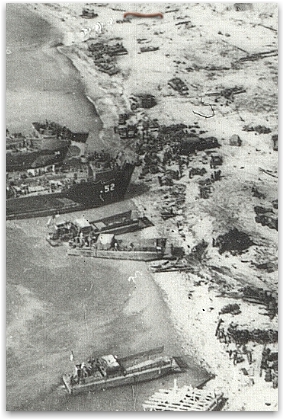Plan for Corregidor
A quick stretch of the terrain and tactical plan
before I continue with the close-in air and naval support will clarify
the story. Corregidor is a tadpole stretched out from west to east in
the entrance of Manila Bay. The head of this polliwog (the west end of
the island) is called Topside. It is a 500-foot high plateau that drops
into deep ravines and cliffs to the water’s edge on all sides, and this
part of the island is 2,500 yards in diameter.
The thin waist of the tadpole is called Bottomside.
It is about five hundred yards wide and rises about twenty five feet
above the water. Overlooking Bottomside and to the east of it is steep,
jagged, 400-foot Malinta Hill. This hill is over 800 yards long from
north to south and only 300 yards wide. The main corridor of Malinta
Tunnel runs through the base of the hill from west to east with a main
entrance at each end. North and south wing tunnels join the main tunnel
inside and come out at smaller entrances on the north and south sides of
the hill. From Malinta Hill to the east, the tail of the tadpole
stretches out for 3,000 yards to its tip.
Corregidor’s long standing nickname, “the Rock,” is a
good one for there is only enough soil over the jumble of rock strata to
support the life of heavy undergrowth. The tactical plan, which was
followed to the letter, called for the 503d Paratroop Regiment to land
two battalions on Topside by parachute at 0830. The 3d Battalion, 34th
Infantry, was to land near South Dock on the south shore of Bottomside
at 1030, secure the Bottomside area and Malinta Hill. From there on,
priority one was to open the road from Bottomside to Topside. Priority
two, the 503d would clean up Topside including all its ravines and
cliffs while the 34th held tight on Malinta. Priority three, a drive
down to the east tip from Malinta Hill.
There are a hundred or more stories to tell of how it
all worked out, but I shall stick to air and naval gunfire support.
Air Support Operations
The air support set-up was quite orthodox in
organization but outstanding in ability. Captain Gire, the air liaison
officer, had one lieutenant and four enlisted men. They were equipped
with a radio capable of reaching both the air base and the planes in the
air. An air strike would begin with a request to the air liaison
officer. Sometimes he got his request twelve or more hours in advance,
but a fifteen-minute notice didn’t faze him in the least. Next, an OP
would be established for the strike. At the OP was a ground troop
officer thoroughly familiar with the ground, the tactical situation and
the target. That was usually the battalion CO or executive officer of
the unit being helped by the air strike. The Air Forces lieutenant was
there with a telephone line to the liaison officer at the radio. An 81mm
mortar observer completed the group.
The procedure usually went like this: Captain Gire
called the squadron leader, who was circling overhead with his outfit,
and designated the target on their corresponding air support photos. He
also gave him the position of the nearest friendly troops and a line of
air flight along which overs and shorts would be harmless to us. After
the squadron leader had identified the target and instructed his pilots,
the made a trial run. For the trial run, we marked our lines with
colored smoke and the target with a white phosphorus mortar shell. For
the bombing run the target was again marked the same way and in they
came. The air officer at the OP watched them like a hawk. Control was so
tight that after one pilot had dropped his bomb, the next plane could be
given an adjustment for over or short on the first bomb to make his own
release accordingly. If necessary, the second plane could be turned off
the target. Such an emergency never arose, but that safety measure
definitely could have been taken. That is real air support!





